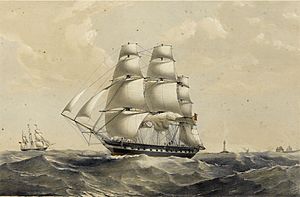Madagascar (1837 ship) facts for kids

The Blackwall Frigate Madagascar
(lithograph, c. 1853) |
|
Quick facts for kids History |
|
|---|---|
| Builder | Wigram and Green, Blackwall Yard, London |
| Launched | 1837 |
| Homeport | London |
| Fate | Lost, 1853 |
| General characteristics | |
| Type | Blackwall Frigate |
| Tonnage | 951 "New Measurement" |
| Length | 150 ft 7 in (45.90 m) |
| Beam | 32 ft 7 in (9.93 m) |
| Draught | 15 ft (4.6 m) fully laden |
| Depth of hold | 22 ft 5 in (6.83 m) |
| Propulsion | Sail |
| Sail plan | Three-masted full-rigged ship |
| Crew | 60 |
The Madagascar was a large British merchant ship built in 1837. It was designed for trade routes to India and China. In 1853, the ship disappeared while sailing from Melbourne, Australia, to London, England. The disappearance of the Madagascar became one of the biggest unsolved mysteries at sea in the 1800s. Many people have wondered what happened to it, even more than for most other ship puzzles of that time, except for the famous Mary Celeste.
Contents
The Ship's Journey and Purpose
The Madagascar was the second ship of its kind, known as a Blackwall Frigate. It was built by George and Henry Green at the Blackwall Yard shipyard in London. They owned this shipyard with the Wigram family.
Who Owned and Sailed the Ship?
Captain William Harrison Walker owned a small part of the ship for its entire 16-year life. The Green family members owned the rest of the ship. The Madagascar carried goods, passengers, and troops between England and India. This continued until late 1852.
Training Young Sailors
Besides its regular crew, the ship also carried many young boys. These boys were being trained to become officers for the merchant marine. They were called midshipmen, similar to how young officers were trained in the navy. Their parents or guardians paid for their training. The boys usually earned only a small wage, about a shilling a month.
The Final Voyage of the Madagascar
In 1853, the Madagascar was sent to Melbourne, Australia. This was because of the Victorian Gold Rush, which brought many people to Australia. The ship carried people who were moving to Australia. Captain Fortescue William Harris was in command of the ship for this trip.
Arrival in Melbourne
The Madagascar left Plymouth, England, on March 11, 1853. It had a smooth journey of 87 days. The ship arrived in Melbourne on June 10. When they arrived, 14 of the 60 crew members left the ship. They wanted to go to the goldfields. It is thought that only about three new crew members joined the ship.
Loading Cargo and Passengers
After arriving, the ship was loaded with new cargo. This included wool, rice, and about two tonnes of gold. The gold was worth a lot of money, around £240,000. The ship also took on about 110 passengers. These passengers were traveling back to London.
Unexpected Delays
On Wednesday, August 10, the ship was getting ready to sail. However, police came aboard and arrested a man named John Francis. He was believed to be involved in a recent incident where a private escort carrying gold was taken. The next day, the police arrested two more people. One was on the ship, and the other was about to board. Because of these arrests, the Madagascar did not leave Melbourne until Friday, August 12, 1853.
The Ship's Disappearance
After leaving Port Phillip Heads, the Madagascar was never seen again. When the ship did not arrive in London on time, many ideas were suggested about what happened.
Theories About the Disappearance
Some thought the wool cargo might have caught fire by itself. Others believed the ship might have hit an iceberg. The most debated idea was that some passengers or crew members might have taken over the ship. This theory suggested they stole the gold and caused the ship to sink. The remaining passengers and crew would have disappeared under suspicious circumstances.
The Legacy of the Mystery
The mystery of the Madagascar continued for many years. In 1872, stories began to spread about a person who supposedly confessed on their deathbed. This person claimed to know what happened to the ship's captain.
Fictional Stories and Influence
Over the next century, many fictional stories were written based on this rumor. Famous authors like Basil Lubbock and James A. Michener even mentioned it. The legend of the Madagascar has been used many times in popular books. One of the earliest was Frank Fowler's Adrift; or The Rock in the South Atlantic. This book likely started the modern stories about a possible takeover. Later, Thomas Harrison wrote My Story; or, the Fate of the "Madagascar". This was first published in a magazine in 1868. The mystery also influenced other sea stories from the gold-rush era. These include Clark Russell's The Tale of Ten: A Salt Water Romance in 1896. It also inspired the story of the alleged loss of the Starry Crown, which was presented as fact in T. C. Bridges' The Romance of Buried Treasure in 1931. This story was then used by Captain W. E. Johns in his 1949 book Biggles Breaks the Silence. More recently, Sandy Curtis used the mystery in her book Deadly Tide (2003).

